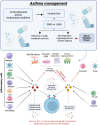Targeting IL-13 and IL-4 in Asthma: Therapeutic Implications on Airway Remodeling in Severe Asthma
- PMID: 40257546
- PMCID: PMC12011922
- DOI: 10.1007/s12016-025-09045-2
Targeting IL-13 and IL-4 in Asthma: Therapeutic Implications on Airway Remodeling in Severe Asthma
Abstract
Asthma is a chronic respiratory disorder affecting individuals across all age groups. It is characterized by airway inflammation and remodeling and leads to progressive airflow restriction. While corticosteroids remain a mainstay therapy, their efficacy is limited in severe asthma due to genetic and epigenetic alterations, as well as elevated pro-inflammatory cytokines interleukin-4 (IL-4), interleukin-13 (IL-13), and interleukin-5 (IL-5), which drive structural airway changes including subepithelial fibrosis, smooth muscle hypertrophy, and goblet cell hyperplasia. This underscores the critical need for biologically targeted therapies. This review systematically examines the roles of IL-4 and IL-13, key drivers of type-2 inflammation, in airway remodeling and their potential as therapeutic targets. IL-4 orchestrates eosinophil recruitment, immunoglobulin class switching, and Th2 differentiation, whereas IL-13 directly modulates structural cells, including fibroblasts and epithelial cells, to promote mucus hypersecretion and extracellular matrix (ECM) deposition. Despite shared signaling pathways, IL-13 emerges as the dominant cytokine in remodeling processes including mucus hypersecretion, fibrosis and smooth muscle hypertrophy. While IL-4 primarily amplifies inflammatory cascades by driving IgE switching, promoting Th2 cell polarization that sustain cytokine release, and inducing chemokines to recruit eosinophils. In steroid-resistant severe asthma, biologics targeting IL-4/IL-13 show promise in reducing exacerbations and eosinophilic inflammation. However, their capacity to reverse established remodeling remains inconsistent, as clinical trials prioritize inflammatory biomarkers over long-term structural outcomes. This synthesis highlights critical gaps in understanding the durability of IL-4/IL-13 inhibition on airway structure and advocates for therapies combining biologics with remodeling-specific strategies. Through the integration of mechanistic insights and clinical evidence, this review emphasizes the need for long-term studies utilizing advanced imaging, histopathological techniques, and patient-reported outcomes to evaluate how IL-4/IL-13-targeted therapies alter airway remodeling and symptom burden, thereby informing more effective treatment approaches for severe, steroid-resistant asthma.
Keywords: Anti-IL-13; Anti-IL-4; Asthma, airway remodeling; Interlukin-13 (IL-13); Interlukin-4 (IL-4).
© 2025. The Author(s).
Conflict of interest statement
Declarations. Competing Interests: The authors declare no competing interests.
Figures
References
Publication types
MeSH terms
Substances
Grants and funding
LinkOut - more resources
Full Text Sources
Medical




